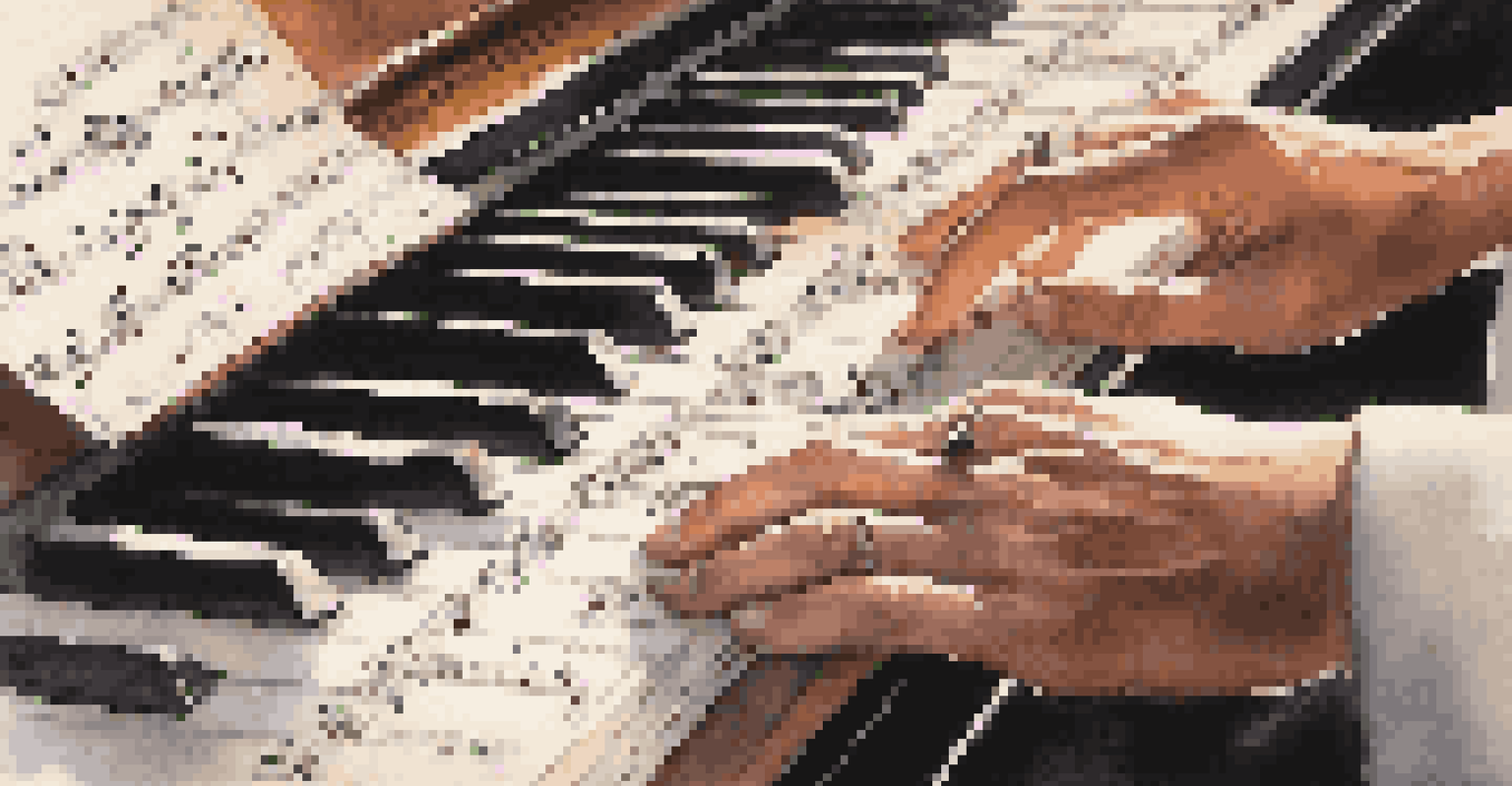The Relationship Between Music, Emotion, and Nonverbal Gestures

Understanding the Emotional Power of Music
Music has a unique ability to evoke emotions, often transporting us to different places in our minds. For instance, a soothing melody can bring a sense of calm, while an upbeat tune might inspire joy and movement. This emotional connection is something many of us have experienced, whether it's through a song that resonates during a tough time or a track that gets us on our feet.
Where words fail, music speaks.
Research shows that music activates various brain regions associated with emotions, including the amygdala and prefrontal cortex. These areas are crucial for processing feelings and making decisions, which explains why a particular song can trigger vivid memories. The emotional responses we have to music can be deeply personal, influenced by our experiences and associations.
In essence, music serves as a universal language for expressing feelings, transcending barriers of culture and language. Just think of how a film score can heighten tension or evoke nostalgia, illustrating the profound impact music has on our emotional landscape.
The Role of Nonverbal Gestures in Communication
Nonverbal gestures are an essential part of human communication, often conveying more than words ever could. Think of a simple smile or a nod; these actions can express agreement or affection without a single word being spoken. This silent language plays a significant role in how we understand and connect with others, especially when emotions are involved.

Gestures can enhance our emotional expressions, making them more relatable and powerful. For example, a person might raise their hands in excitement or clasp them together in a moment of prayer, both conveying strong feelings without verbalizing them. This synergy between gestures and emotions helps to create a more engaging and expressive interaction.
Music Evokes Deep Emotions
Music has a unique ability to evoke a wide range of emotions, influencing our feelings and memories through melodies and rhythms.
Moreover, understanding nonverbal cues can deepen our emotional awareness and empathy. By recognizing the gestures of others, we can better grasp their feelings, leading to a more profound connection and understanding in our interactions.
How Music Influences Our Nonverbal Expressions
Music not only stirs emotions but also influences how we express those feelings through gestures. For instance, when we hear an upbeat song, we often find ourselves dancing or tapping our feet, reflecting our internal joy. In contrast, a slow, melancholic tune might lead us to a more subdued posture, echoing the sadness of the music.
Music can change the world because it can change people.
This interplay between music and nonverbal gestures highlights how sound can shape our physical responses. When listening to a powerful symphony, it’s common to see audiences swaying or closing their eyes, lost in the moment. Such reactions can be spontaneous, demonstrating the immediate impact music has on our bodies and emotions.
In many ways, music acts as a catalyst for our nonverbal communication, inviting us to express what we feel in a more visceral way. This connection can be seen in live performances, where the energy of the music inspires both the artist and the audience to engage in a shared emotional experience through movement.
The Science Behind Music and Emotion
The relationship between music and emotion is not just anecdotal; it has been the subject of extensive scientific research. Studies reveal that certain musical elements—like tempo, key, and harmony—can elicit specific emotional responses. For instance, fast tempos and major keys often evoke happiness, while slow tempos and minor keys can evoke sadness.
Neuroscientific research shows that listening to music releases dopamine, a neurotransmitter associated with pleasure and reward. This biological response explains why we might feel a rush of happiness when our favorite song plays. It’s fascinating to think that something as simple as a melody can trigger such complex emotional reactions in our brains.
Nonverbal Communication Enhances Emotion
Nonverbal gestures play a crucial role in expressing emotions, often conveying more than words can, and enhancing our connections with others.
Understanding these scientific underpinnings not only deepens our appreciation for music but also highlights its therapeutic potential. Music therapy, for instance, uses these principles to help individuals manage emotions, reduce stress, and improve overall well-being, showcasing the profound connection between music and human emotion.
Cultural Perspectives on Music and Emotion
Music's emotional resonance isn't uniform; it varies significantly across different cultures. Each culture has its own musical styles, instruments, and traditions that evoke specific feelings and meanings. For instance, traditional African drumming often signifies celebration, while Indian classical music may convey deep spirituality and introspection.
These cultural nuances shape how we respond to music and interpret emotions in a musical context. What might sound joyful in one culture could be perceived as somber in another, reflecting the diverse emotional landscape of human experience. This diversity enriches our understanding of music as a form of emotional expression.
Moreover, cultural contexts influence nonverbal gestures associated with musical performances. In many cultures, dance is an integral part of music, serving as a physical manifestation of the emotions conveyed through sound. By exploring these cultural perspectives, we gain a broader appreciation for the intricate relationship between music, emotion, and human expression.
Music as a Tool for Emotional Expression
For many individuals, music serves as a powerful outlet for emotional expression. Composing or performing music can lead to catharsis, allowing artists to articulate feelings they might struggle to express otherwise. This process not only benefits the creator but also resonates with listeners who find solace in shared emotional experiences.
Consider how songwriting can be a form of therapy; artists often write about their struggles, joys, and heartaches, connecting deeply with their audience. When listeners hear these songs, they may feel understood and validated, creating a shared emotional journey. This connection can be incredibly powerful, fostering community and empathy among diverse groups.
Cultural Variations in Musical Emotion
The emotional response to music varies across cultures, reflecting diverse meanings and expressions tied to specific musical traditions.
In this way, music becomes a bridge for emotional expression, allowing us to communicate feelings that words alone cannot capture. Whether through lyrics, melodies, or rhythms, music provides a unique vehicle for conveying the full spectrum of human emotions.
The Future of Music, Emotion, and Gestures
As technology evolves, so does our relationship with music and its emotional impact. Innovations like virtual reality and immersive audio experiences are reshaping how we engage with music, allowing for deeper emotional connections. Imagine attending a virtual concert where the music and visuals synchronize perfectly to amplify the emotional experience.
Additionally, artificial intelligence is beginning to play a role in music creation, raising questions about authenticity and emotional depth. While AI can compose music that resonates emotionally, it lacks the lived human experience that often fuels genuine artistic expression. This ongoing dialogue between human and machine creativity will shape the future of music and its emotional resonance.

As we move forward, the interplay between music, emotion, and nonverbal gestures will continue to evolve. By embracing these changes while honoring the profound connections we've established, we can look forward to a future where music remains a vital expression of our shared humanity.